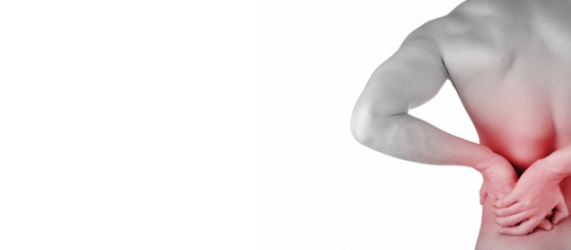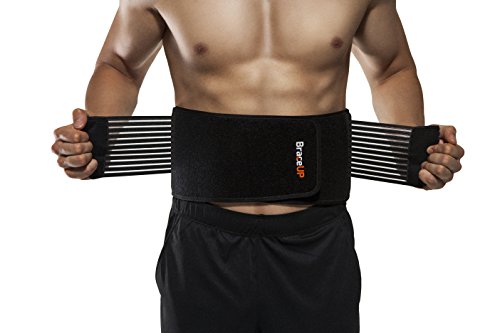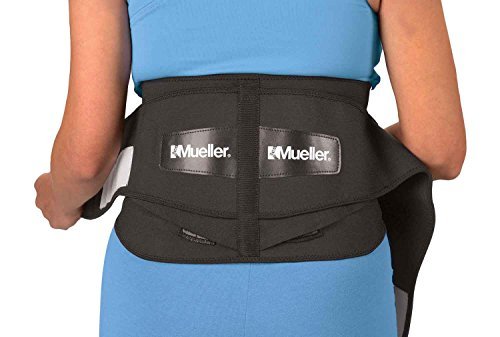Lower back pain and injuries are common among weightlifters and even non-weightlifters. As I have discussed in Shoes, Sitting, and Lower Body Dysfunctions a lot of this stems from shoes and sitting and how they may have chronic detrimental effects on our bodies. Combine this with poor technique, especially in lifting objects off the ground or during working out, and you have a recipe for pain and injury.
Table of contents
- Introduction and General Categories of Lower Back Injuries
- Bulging and herniated discs
- Sacroiliac Joint Issues
- Low Back Strains
- Braces
- Conclusion
This short article is not going to be an end all article on how to solve lower back pain and injury. Rather, there are categories of lower back injuries that all need different attention depending on what has been injured. From there we can determine what the best course of action that needs to be taken for each individual because everyone is a bit different.
Disclaimer: Any information contained herein is not professional medical or physical therapy advice. Always consult your doctor or physical therapist before using such information.
Introduction and General Categories of Lower Back Injuries
Typically, when you injure your back, some sort of mechanical issue with pain accompanies it. This mechanical issue usually can be fixed to a certain extent. Even if it is permanent, it will likely not be disabling. (Studies have determined that even many non-athletes have bulging/herniated discs that do not cause pain or impair their ability to function.) Both the injury and the accompanying pain set off a process of dysfunction that causes the back muscles to spasm. This causes more pain and tightness that exacerbates the injury, and a negative feedback loop is born. Pain “turns off ” the segmental stabilizer muscles around the spine, which causes dysfunction in timing for core activation, particularly in the transverse abdominis muscle. The body compensates by turning on “global muscles” in the core (such as spinal erectors) for stability, exacerbating the negative feedback loop. This is why your global muscles feel extremely tight after a back injury and why foam rolling or massage does not fix the problem—it is actually a stability issue. The solution involves correcting the timing of core activation by performing stability work for the deep, segmental muscle stabilizers. This rehabilitation method will naturally ease the tightness in the lower back.
Many of the exercises used in rehabilitation are the same movements a toddler performs when learning to walk. It is important to realize this. A toddler’s movements train a nervous system that has not yet
learned how to properly coordinate fundamental movements like rolling, crawling, and controlling the head. For example, segmental rolling (the manner in which a baby first learns how to roll) activates the core with correct timing and teaches each of the muscle stabilizers between the vertebrae how to fire correctly, as all of the segments are moving independently. An athlete’s rehabilitation exercises help sequence the correct firing and timing of muscles as these gross movement patterns are re-learned.
Physical therapy rehabilitation involves first getting your muscles to activate at the proper time and then
stabilizing the area of an injury. You build upon these reinforced fundamental movement patterns with isolation work, followed by compound movements as you work your way back to where you were before the injury.
Lower back pain/injury is common among both weightlifters and non-weightlifters. There are many fac
tors that can lead to lower back issues including the type of shoes you wear, the way you sit, lifting heavy items, poor alignment, and biomechanics. Combine any of these with poor exercise or bad technique and the chance of injury increases exponentially. If you are training your lower body with squats, deadlifts, and other solid compound exercises, you may run into trouble with your lower back at some point. These issues will probably not happen while performing bodyweight exercises (if you focus on good technique), but they often will occur from rounding the back too much while stretching.
All of the different types of lower back injuries mentioned in the upcoming section require specialized
attention. In some cases, you will be able to correct the issue yourself; other cases will require you to see a medical professional. When in doubt, always do the latter.
Flexion-based injuries occur from lower back rounding during a lift. The back is strongest when it has a
natural curvature, and lifting with a rounded back puts your discs in a place where they can potentially fail.
Flexion based injuries from lower back rounding tend to fall in 3 different categories.
- Bulging or herniated discs
- Sacroiliac joint (SI joint) slip or rotation
- Strained/pulled muscles
These are the three we will learn how to identify which one you may have, and then how to obtain professional treatment if required and/or general treatment strategies.
Other types of injuries are not very common and if obtained from lifting in particular may represent some inherent structural deficiency or faulty connective tissue usually due to genetics or improper nutrition. Additionally, accidental injuries from falling and/or literally breaking a bone are not covered in this particular article.
If you suspect you have an injury that does not fall into any of the three categories above see medical professional as soon as possible. Also, if you have an injury which presents debilitating pain or presents possible insidious neurological symptoms such as sensory or motor deficits see a medical professional immediately. Motor deficits are critical enough that they may require an ER visit.
Bulging and herniated discs
Bulging or herniated discs will cause pain on, in, or around the spine itself. You will feel it in the direct center of your back. If the issue is low enough on the spine, it may also impinge on the nerve roots that emerge from the spinal column. This causes radiating pain from the side of the spine or lower extremities called radiculopathy. The most common type of radiculopathy is sciatica. This typically manifests as radiating pain around the buttock region, which may continue into the legs—even as far down as the foot.
Action Steps: It is best to see an orthopedic doctor so they can assess the injury, which may require
an MRI. From there, proper treatment can be determined. You will often be referred to a physical therapist before any surgery or steroid injections. They can help you work your way back to full exercise, but you must take care not to aggravate the injury, as this may lead to permanent conditions. In the meantime, there will be inflammation accompanying the pain. These symptoms can be relieved with proper mobility work.
Because every individual is different, exercises prescribed will vary. Some exercises will make the pain
worse, some will help the pain, and some will have a neutral effect. Here is a list to get you started. Many of these are fundamental movements that you learned as a toddler. Try a few and find out what works best for you.
McKenzie exercises
Cat-Camels
Bird-Dogs
Glute bridges
side bridges (+ modifications of some of the above)
Reverse hyperextensions
Reverse hyperextensions (shown above) are particularly good for rebuilding strength, stability, and
hypertrophy in the lower back. These can be used for prehabilitation prior to returning to classic compound exercises like squats and deadlifts. This exercise has a very high success rate. Light kettlebell swings can also be used effectively.
Update: I recently injured and aggravated my back in a similar manner to this post. You can read about how I rehabbed myself from crippled to 100% in 10 days. As always, check with your medical provider(s) before doing any type of exercises.
Generally speaking, the aggravating exercises method applies here. The aggravating exercise “method” is that pain tends not to be an accurate indicator during rehabilitation, except during the initial few days of injury. Improved function may be accompanied with pain or not. Therefore, the standard of improvement is shifted away from “pain” to improvements in “performance” and “function.” Of course, the process of determining whether something is necessary and/or needed to improve performance or function that is painful is typically best done under a qualified medical professional’s judgment. I do not recommend anyone do it without it.
The value of non-painful mobility work can not be overstated. The main reason to avoid pain in this case
is to avoid the sensitization which leads to tightening of the surrounding musculature. As your body begins to heal, your range of motion without pain should increase. Non-aggravating mobility work will substantially aid in this process. Focus on regaining mobility and strength in your ankles and hips and improving core strength and stability in your knees, arches, and your lower back in particular.
Sacroiliac Joint Issues
During improper lifting or bending, one side of your muscles may fail earlier than the other side. (We all have a dominant side.) If the weight is not immediately deloaded or your muscles do not strain, your sacroiliac (SI) joint may slip or become rotated, causing pain. This may also occur if a significant impact is made on one leg more often than the other, such as in uneven landings in gymnastics, parkour, or martial arts, and other disciplines.
SI joint issues tend to manifest pain directly above the butt crack and an inch or two to either side,
depending on which joint has slipped or rotated. It is similar to the lower disc issues, so a slipped SI joint can also manifest as sciatica or any other form of radiculopathy.
If you run your hands down your sides from your ribs to your pelvis, the first bony protrusion you will
encounter is called the iliac crest. This is at the level of the L4-L5 spinal disc. If you follow the iliac crest
backward with your hand (it slopes downward) you will encounter your SI joint, which is located where your pelvis meets your sacral vertebrae. Your SI joint is about four inches long, so the pain may be located any where along it. If the pain is in this area, you may have an SI joint issue.
A slipped SI joint can manifest in one leg being functionally shorter than the other. When you locate
your iliac crest, if one side is higher than the other, this may be an indication of an SI joint slip. On the other hand, a rotated SI joint might not manifest in a leg length discrepancy. If your pain is (1) one to two inches off-center from your spine, (2) is one to two inches lower than your iliac crest, and (3) feels like it is in the bony region of the pelvis—you may have an SI joint issue.
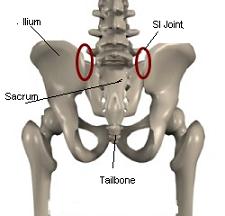
Action Steps: It is best to see a chiropractor and/or physical therapist. They should be able to correct the issue with various techniques.
If your SI joint is slipped and/or rotated, some muscles will be longer or shorter than usual. When an
injury occurs, your body’s natural response is to lock down the muscles to prevent further injury; in this case, that is not good news. You should see a chiropractor or physical therapist as soon as possible to correct this issue. While you are waiting for your appointment, keep your muscles loose by massaging them. You may also apply heat—just make sure it is not placed directly on the SI joint. You could place a heating pad on your lower back and/or hip muscles instead of your SI joint.
Few people have corrected SI issues themselves; it is not recommended unless you already have some level of experience. Performing a “fix-it” technique incorrectly will make your condition worse in the long run. If you are adamant about self-treating an SI issue, be aware that any technique used should correct the issue within one to three attempts. If you have not corrected the issue and you continue to perform your technique (such as cracking your back) repeatedly, you could do serious damage to your body.
You may be able to check yourself with the long sit test – legs will be uneven lying on the back (e.g. pelvis oriented upwards), but when you sit up they will be even because the slip doesn’t manifest when the pelvis is oriented forwards. If you find this is the case, definitely see a professional immediately. Also, even if this doesn’t work but you still suspect something I would see a professional anyway.
There are many other Joint Mobilization Techniques for Sacroiliac Joint Dysfunction. However, since there are so many it generally takes a skilled professional to accurately quantify what you have (you cannot do it yourself well at all). If you have pain over the SI joint or feel like you have a shifted SI/low back/pelvic area I would suggest you see a physical therapist about this.
Here’s more information about different techniques.
SI joint evaluation
SI joint manipulation
Similar to the above
A different manipulation
Low Back Strains
If the pain in your lower back is below your ribs and above your SI joint, you likely have a strained muscle. Strained and pulled lower back muscles will be located in the muscle belly of your tissues on either side of your spine. Strains will usually occur during lifting, in your spinal erectors (the iliocostalis, longissimus, and spinalis muscles), but they can also occur in the quadratus lumborum and other muscles as well.
If you strain or pull a muscle, you do not need to see a doctor unless the injury is severe. Most doctors will give you a prescription for painkillers and tell you to rest. That said, if your tissues are turning black and blue and you feel like you need painkillers, see a doctor.
Action Steps: The etiology and rehabilitation of muscle strains have been addressed in prior articles. However, other injuries sometimes appear to be strains because the muscles around an area of injury often tighten up or cramp. If you follow protocol and your issue persists, see a physical therapist.
That said, if your injury is more than two inches away from your spine and located within the muscle
belly and not in the SI joint area, it is probably a muscle strain. If the pain radiating and located within two inches of the spine, it may be a bulging or herniated disc. If the pain is much lower (between the iliac crest and butt crack) and slightly offset, it is likely an SI joint issue.
Braces
Generally speaking, brace braces may help with the pain, but they generally won’t fix the injury. If you do decide to get a back brace to help with the pain, you should definitely continue to seek treatment and rehabilitation so that you can eventually wean yourself off the brace as you improve.
Braces that compress the core like these tend to be effective. Most people who do not have back surgery do not need a specialized bracing method. If you are confused about if you may want or need one for your particular situation, then consult the appropriate medical professional.
Conclusion
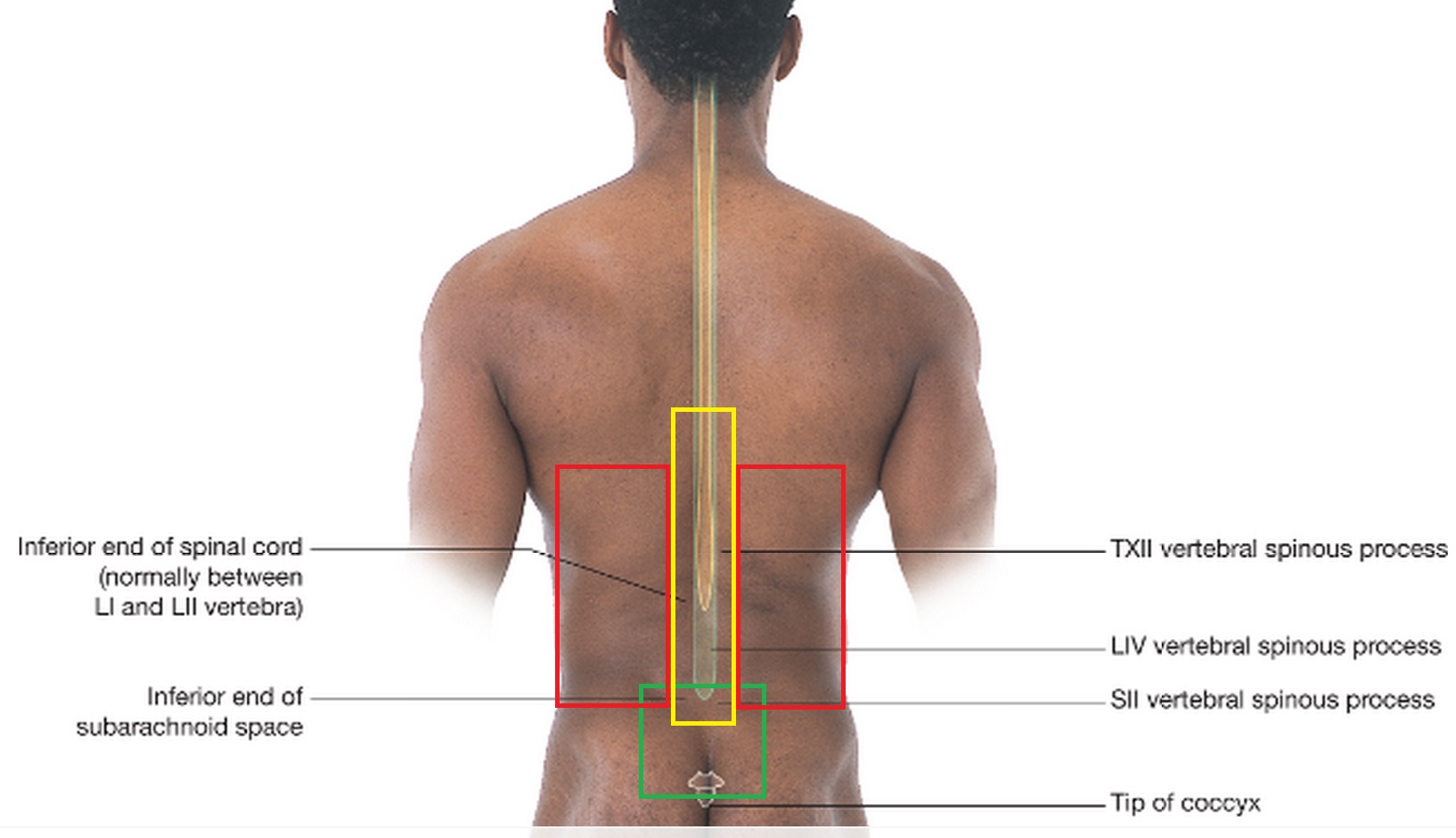
This picture is a “general” schematic of how to assess if it is spinal, SI joint, or muscular if you are having trouble with the descriptions.
Red — this area is all muscle and connective tissue and thus the things that tend to give first during exercises is muscles. Thus, this region indicates for the most part strains.
Yellow — obviously this is on the spine which indicates if there’s pain in or extremely close to the spine that either there’s a problem with the discs or the nerve roots coming out. This may radiate down into the butt and leg.
Green — The SI joints are located here, about an inch or two below the iliac crest (which is at L4-L5) a couple inches on either side of the spine. This or spinal problems can and may refer shooting pain down the leg as well.
The goal of this article was to provide information to help individuals assess what they need to do in case of certain lower back injuries and where to seek proper treatment. Getting proper treatment quickly will help shorten recovery time, and get you back to daily life or your workouts much faster.
This article was originally published February 1st, 2010 on Eat Move Improve. Updated Jan 2017.
Questions about articles may be addressed to the Overcoming Gravity reddit.
Disclaimer: Any information contained on this site should not be misconstrued as professional medical advice. Always consult your appropriate medical professional before using such information. Use of any information is at your own risk.
I may earn a small commission for my endorsement, recommendation, testimonial, and/or link to any products or services from this website. Your purchase helps support my work on education on health and fitness. See also: Full disclosure of site terms and conditions.
Author: Steven Low
Steven Low is the author of Overcoming Gravity: A Systematic Approach to Gymnastics and Bodyweight Strength (Second Edition), Overcoming Poor Posture, Overcoming Tendonitis, and Overcoming Gravity Advanced Programming. He is a former gymnast who has performed with and coached the exhibitional gymnastics troupe, Gymkana. Steven has a Bachelor of Science in Biochemistry from the University of Maryland College Park, and his Doctorate of Physical Therapy from the University of Maryland Baltimore. Steven is a Senior trainer for Dragon Door’s Progressive Calisthenics Certification (PCC). He has also spent thousands of hours independently researching the scientific foundations of health, fitness and nutrition and is able to provide many insights into practical care for injuries. His training is varied and intense with a focus on gymnastics, parkour, rock climbing, and sprinting. Digital copies of the books are available in the store.
